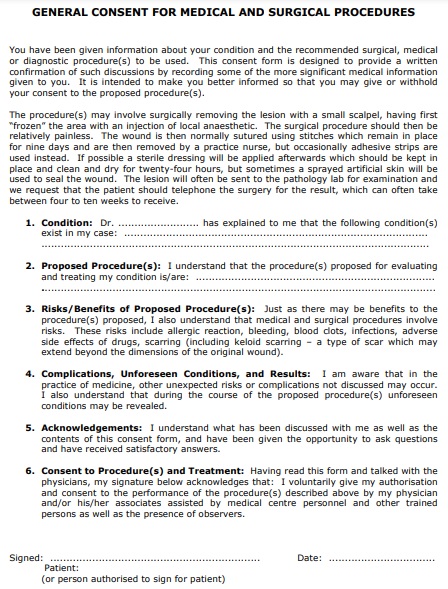A surgical consent form is used to get both general consent and informed consent by the patient any time surgery is going to be performed.
Table of Contents
What is surgical consent?
A surgical consent is a way of giving permission to your physician to perform a surgical procedure. The consent can be given either orally or in writing. It is considered a criminal offense to do surgery on a patient without his/her permission. Before giving consent, the physician should thoroughly explain the following;
- what the procedure entails
- why they should have it
- what risks and side effects they may experience
- all aftercare treatment
This is considered informed consent. You would use a Surgical Consent Form that the patient signs after reading everything thoroughly.
What is a surgical consent form?
The main purpose of the surgical consent form is to make sure that a patient has been provided all of the important details related to individual or surgical procedures. Along with how minor or non-life threatening the procedure may be the form should also outline any type of risk that is associated with the procedure.
A physician shouldn’t guarantee that there is no danger to the patient or that the system will cure the underlying issue. On the form, there must be a separate section regarding anesthesia that can come with its risks not related to the actual surgery. It is similar for potential blood transfusions that may be required during the operation.
Moreover, the form should contain the names of the physician doing the surgery and the name of the anesthesiologist. Sometimes a certified registered nurse anesthetist is overseeing the anesthesia process instead of an anesthesiologist. So, it should be described in the way of the limited training of a CRNA in comparison to an anesthesiologist.
Legal issues regarding surgical consent:
In some cases, a patient can revoke consent for surgery even after the operation has been done. This would include cases where a patient;
- Had a mental illness
- Had a mental disability
- Was under duress (stress or pain)
- Was in labor
- Was semi-conscious
- Was under the affect of alcohol, drugs, etc
- Was a minor
Under these situations, the patient isn’t mentally able to make the right choice for themselves. Also, the consent itself was not completely voluntary. You may also like Medical Authorization Letter.
General Consent for Medical Surgical Form
Informed Consent to Surgery Form
Swedish Surgical Consent Form
Surgery without consent:
During routine operations, surgery without consent can also occur where the patient did consent. For instance, going in for routine surgery the physician discovers another issue. Then, they have to perform another surgery when they are doing the original surgery. At that time, the physician may felt that the second surgery was necessary. Since the patient did not consent to the second surgery so if the situation is life-threatening, the surgeon only performs additional surgery then.
Another example of surgery without consent is that during surgery, a patient tells the surgeon they cannot have a blood transfusion as it goes against their religious beliefs. However, this may give arise to complications and to save the patient’s life, the surgeon gives a blood transfusion. In both cases, a surgeon is accountable for performing surgery without consent.
Conclusion:
In conclusion, a surgical consent form is an important tool in order to make sure that a patient has been given all of the essential details relevant to individual or surgical procedures. Any time surgery is going to be performed, a surgical consent form will be filled out.









